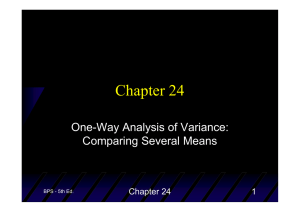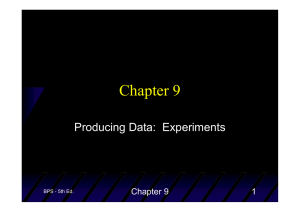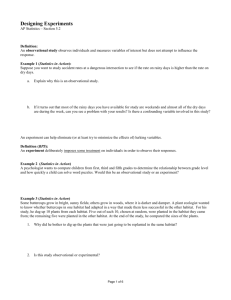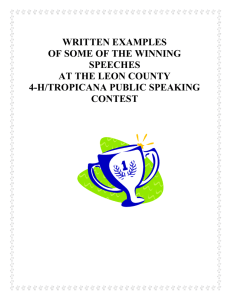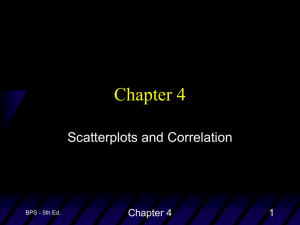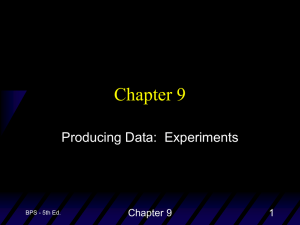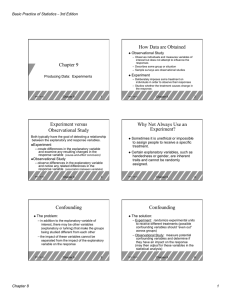Chapter 9 Producing Data: Experiments 1 BPS - 5th Ed.
advertisement
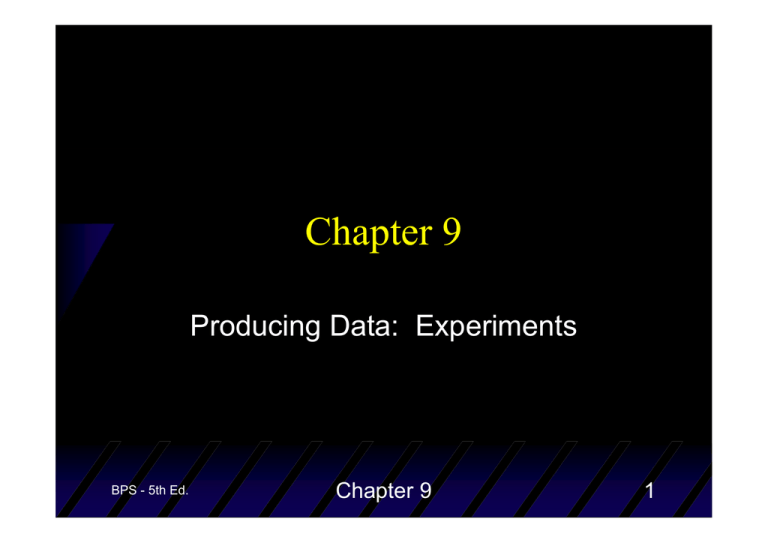
Chapter 9 Producing Data: Experiments BPS - 5th Ed. Chapter 9 1 Experiment versus Observational Study Both typically have the goal of detecting a relationship between the explanatory and response variables. XExperiment – create differences in the explanatory variable and examine any resulting changes in the response variable (cause-and-effect conclusion) XObservational Study – observe differences in the explanatory variable and notice any related differences in the response variable (association between variables) BPS - 5th Ed. Chapter 9 2 Why Not Always Use an Experiment? X Sometimes it is unethical or impossible to assign people to receive a specific treatment. X Certain explanatory variables, such as handedness or gender, are inherent traits and cannot be randomly assigned. BPS - 5th Ed. Chapter 9 3 Confounding X The problem: – in addition to the explanatory variable of interest, there may be other variables (explanatory or lurking) that make the groups being studied different from each other – the impact of these variables cannot be separated from the impact of the explanatory variable on the response BPS - 5th Ed. Chapter 9 4 Confounding X The solution: – Experiment: randomize experimental units to receive different treatments (possible confounding variables should “even out” across groups) – Observational Study: measure potential confounding variables and determine if they have an impact on the response (may then adjust for these variables in the statistical analysis) BPS - 5th Ed. Chapter 9 5 Experiments: Vocabulary X Subjects – individuals studied in an experiment X Factors – the explanatory variables in an experiment X Treatment – any specific experimental condition applied to the subjects; if there are several factors, a treatment is a combination of specific values of each factor BPS - 5th Ed. Chapter 9 6 Experiments: Basic Principles X Randomization – to balance out lurking variables across treatments X Placebo – to control for the power of suggestion X Control group – to understand changes not related to the treatment of interest BPS - 5th Ed. Chapter 9 7 Double-Blind Experiments X If an experiment is conducted in such a way that neither the subjects nor the investigators working with them know which treatment each subject is receiving, then the experiment is double-blinded – to control response bias (from respondent or experimenter) BPS - 5th Ed. Chapter 9 8 Completely Randomized Design X In a completely randomized design, all the subjects are allocated at random among all of the treatments. – can compare any number of treatments (from any number of factors) BPS - 5th Ed. Chapter 9 9 Statistical Significance X X X If an experiment (or other study) finds a difference in two (or more) groups, is this difference really important? If the observed difference is larger than what would be expected just by chance, then it is labeled statistically significant. Rather than relying solely on the label of statistical significance, also look at the actual results to determine if they are practically important. BPS - 5th Ed. Chapter 9 10 Statistical Significance A Probabilistic Interpretation Question: for a given coin how do we know it is a fair coin (equal chance to get head or tail after tossing)? Can we claim it is fair if we toss 10 times and get 4 heads and 6 tails? Or can we claim it is fair if we toss 10 times and get 1 heads and 9 tails? BPS - 5th Ed. Chapter 9 11 Example: Do antioxidants prevent cancer? People who eat lots of fruits and vegetables have lower rates of colon cancer than those who eat little of these foods. Fruits and vegetables are rich in “antioxidants” such as vitamins A, C, and E. Will taking antioxidants help prevent colon cancer? A medical experiment studied this question with 864 people who were at risk of colon cancer. The subjects were divided into four groups: daily betacarotene, daily vitamins C and E, all three vitamins every day, or daily placebo. After four years, the researchers were surprisded to find no signifcant difference in colon cancer among the groups. BPS - 5th Ed. Chapter 9 12 Example: Do antioxidants prevent cancer? (a) (b) (c) (d) (e) What are the explanatory and response variables in this experiment? Outline the design of the experiment. Use your judgment in choosing the group sizes. The study was double-blind. What does this mean? What does “no significant difference” mean in describing the outcome of the study? Suggest some lurking variables that could explain why people who eat lots of fruits and vegetables have lower rates of colon cancer. The experiment suggests that these variables, rather than the antioxidants, may be responsible for the ovserved benefits of fruits and vegetables. BPS - 5th Ed. Chapter 9 13 Pairing or Blocking X Pairing or blocking – to reduce the effect of variation among the subjects – different from a completely randomized design, where all subjects are allocated at random among all treatments BPS - 5th Ed. Chapter 9 14 Matched Pairs Design X X Compares two treatments Technique: – choose pairs of subjects that are as closely matched as possible – randomly assign one treatment to one subject and the second treatment to the other subject X Sometimes a “pair” could be a single subject receiving both treatments – randomize the order of the treatments for each subject BPS - 5th Ed. Chapter 9 15 Block Design X X A block is a group of individuals that are known before the experiment to be similar in some way that is expected to affect the response to the treatments. In a block design, the random assignment of individuals to treatments is carried out separately within each block. – a single subject could serve as a block if the subject receives each of the treatments (in random order) – matched pairs designs are block designs BPS - 5th Ed. Chapter 9 16 Pairing or Blocking: Example from Text Men, Women, and Advertising X Compare effectiveness of three television advertisements for the same product, knowing that men and women respond differently to advertising. – Three treatments: ads (need three groups) – Two blocks: men and women BPS - 5th Ed. Chapter 9 17 Pairing or Blocking: Example from Text Men, Women, and Advertising BPS - 5th Ed. Chapter 9 18 Athletes taking oxygen We often see players on the sidelines of a football game inhaling oxygen. Their coaches think this will speed their recovery. We might measure recovery from intense exertion as follows: Have a football player run 100 yards three times in quick succession. Then allow three minutes to rest before running 100 yards again. Time the final run. You plan an experiment using 25 football players as subjects. Discuss the design of such an experiment to investigate the effect of inhaling oxygen during the rest period. BPS - 5th Ed. Chapter 9 19 Statistical Significance A Probabilistic Interpretation Question: for a given coin how do we know it is a fair coin (equal chance to get head or tail after tossing)? Can we claim it is fair if we toss 10 times and get 4 heads and 6 tails? Or can we claim it is fair if we toss 10 times and get 1 heads and 9 tails? BPS - 5th Ed. Chapter 9 20

